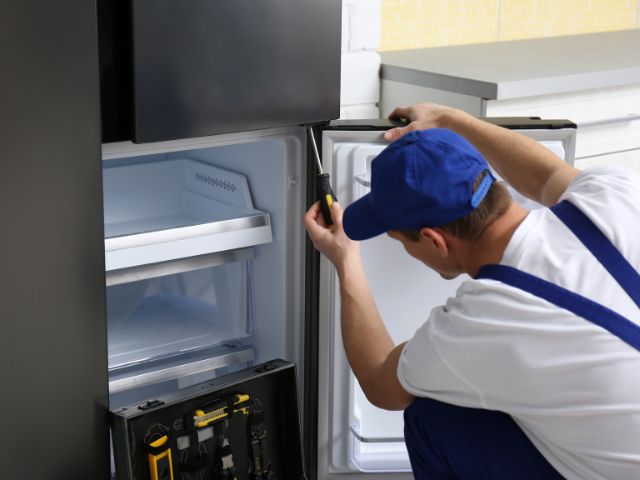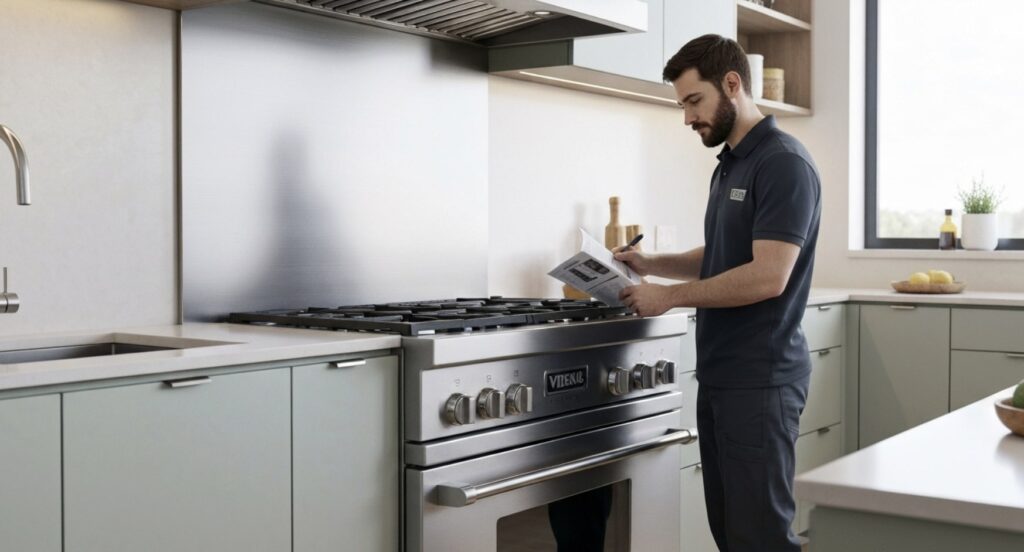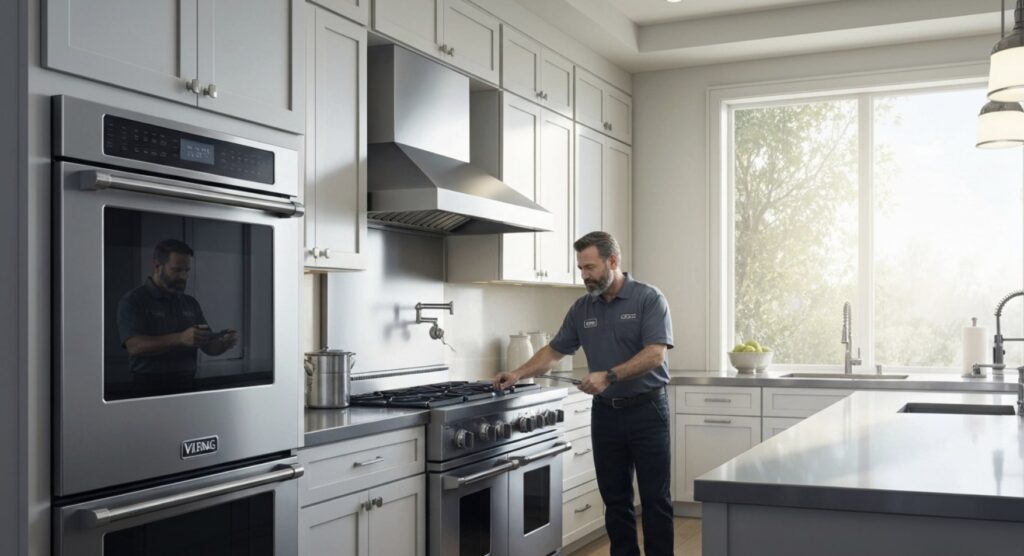Your Viking range is designed for professional-grade performance, but if it’s not holding the right temperature, cooking becomes a frustrating guessing game. Inconsistent heat can ruin recipes and affect meal quality, making it essential to understand and resolve this issue. In this article, we’ll explore the common reasons why a Viking range not holding temperature might happen and provide you with practical solutions to get it working reliably again.
Common Causes of Temperature Issues in a Viking Range
If your Viking range isn’t maintaining the correct temperature, it’s likely due to one or more of the following issues. Knowing these causes will help you determine which solution is best for your situation.
Faulty Temperature Sensor
- The temperature sensor in your oven monitors internal heat levels. If it’s damaged or misaligned, the sensor may send incorrect readings, causing the oven to overheat or cool down unexpectedly.
Worn-Out Igniter
- The igniter plays a crucial role in heating up your oven by igniting the gas. If the igniter is weak or faulty, it won’t light the gas effectively, causing heat fluctuations or preventing the oven from heating altogether.
Thermostat Issues
- The thermostat regulates your oven’s internal temperature, keeping it consistent throughout cooking. If it’s defective, it may not properly signal the heating element to adjust, resulting in erratic temperatures.
Broken Heating Element
- The heating element itself might be the source of the problem. If it’s cracked or worn out, it won’t distribute heat evenly or reach the necessary temperature, leading to uneven or inadequate heating.
Control Board Malfunction
- The control board in your Viking range acts as the brain of the appliance, communicating with other components to ensure proper functioning. When it malfunctions, it may prevent the oven from reaching or holding a steady temperature.
Ventilation Issues
- If the oven’s ventilation is blocked or impaired, the temperature inside may fluctuate due to poor airflow. This can be especially problematic when cooking with higher heat settings.
Solution: Step-by-Step Guide to Fix Temperature Issues in Your Viking Range
Now that you understand the possible causes, let’s go through solutions that can address why your Viking range not holding temperature might occur.
Step 1: Inspect and Align the Temperature Sensor
- Locate the sensor inside your oven, usually positioned at the top of the oven’s back wall.
- Check for misalignment or signs of wear. If it’s crooked or damaged, it may not be reading the temperature accurately.
- If the sensor appears misaligned, gently reposition it to face the center of the oven cavity.
- For further troubleshooting, consider testing the sensor with a multimeter. If the readings are off, a replacement may be necessary.
Step 2: Test and Replace the Igniter if Necessary
- The igniter should glow and heat up to light the gas in your oven. Observe the igniter to see if it is glowing. If it glows weakly or doesn’t ignite, it might need replacement.
- Use a screwdriver to remove the igniter and check for any damage.
- If you suspect the igniter is at fault, consider a replacement part from a reputable appliance parts store.
Step 3: Evaluate the Thermostat Functionality
- Locate the thermostat knob or control on your range and ensure it’s set correctly.
- A faulty thermostat can be harder to diagnose, so consider consulting a professional to test or replace it if necessary.
- In some cases, recalibrating the thermostat (found in the settings of digital models) can resolve minor temperature fluctuations.
Step 4: Check the Heating Element
- Turn off the oven and inspect the heating element for visible cracks or wear.
- If the heating element appears damaged, you can replace it by unscrewing it from its position, unplugging it, and inserting a new one.
- Test the oven after replacing to ensure consistent heating.
Step 5: Inspect the Control Board
- A control board issue often requires specialized attention. Look for signs of visible damage like scorch marks, but refrain from making DIY repairs on the board.
- Contact a qualified technician or reach out to Viking Appliance Repair Pros to assess and repair or replace the control board if needed.
Step 6: Ensure Proper Ventilation
- Blocked ventilation could be another reason for the Viking range not holding temperature. Clean any dirt or debris around the vents to allow proper airflow.
- Avoid using the oven if it’s heavily packed with cookware, as this may obstruct airflow. Instead, distribute items evenly and allow enough space for circulation.
With this guide, you’re now equipped to handle common causes of temperature problems in your Viking range. By taking these steps, you can ensure that your range heats consistently, allowing you to get back to enjoying reliable and delicious meals!
Final Insights
Dealing with a Viking range not holding temperature can be challenging, but understanding the root causes and following these steps can restore your oven’s performance. If these solutions don’t fully resolve the issue, it’s wise to consult professionals who specialize in Viking appliances. Reliable temperature control is crucial for achieving great cooking results, and with some simple fixes or professional touch, you can enjoy a consistently dependable Viking range once again.
Experiencing persistent temperature issues with your Viking range? Our expert team at Viking Appliance Repair Pros is here to help. Contact us for fast, effective solutions to restore your oven’s performance today!
Frequently Asked Questions (FAQs) – Viking Range Troubleshooting
1. Why does my Viking range lose heat during cooking?
Heat loss during cooking can result from a faulty thermostat, igniter, or sensor. Regular inspections and maintenance help ensure optimal temperature consistency.
2. How do I know if my Viking range thermostat is faulty?
A defective thermostat often causes inconsistent temperatures and uneven cooking results. For accurate testing and replacement, professional diagnosis is recommended.
3. Can I replace the igniter in my Viking range myself?
Yes, DIY igniter replacement is possible if you’re comfortable handling small appliance parts. Always disconnect power first and follow your unit’s manual for safety.
4. What should I do if none of the DIY solutions fix my range’s temperature issue?
If troubleshooting doesn’t resolve the problem, the issue may involve the control board, wiring, or other internal components. For guaranteed results, contact Viking Appliance Repair Pros for expert assistance.
Related Resources:
- Viking Refrigerator Repair Tips for Dallas DIYers
- Why Getting a Viking Stove Repair ASAP Is Important
- DIY Fix for an Ice Maker Making Dirty Ice – 6 Easy Steps
- Troubleshooting Blue Bell Viking Microwave Issues
- Expert Viking Appliance Repair Pros – At Your Service
Need Immediate Help?
Don’t let a faulty range ruin your cooking experience. Schedule a service with Viking Appliance Repair Pros today for reliable, same-day Viking appliance repair near you:
- Hawthorne Viking Refrigerator Repair
- Denver Viking Oven Repair
- Los Angeles Viking Freezer Repair
- Glendora Viking Cooktop Repair
- Carson Viking Stove Repair
- Manning Viking Range Repair
- Palos Verdes Estates Viking Refrigerator Repair
- Dallas Viking Refrigerator Repair
- San Francisco Viking Ice Maker Repair
- Portland Viking Oven Repair
Ready to restore your Viking range to peak performance?
???? Book Your Repair Today – Serving multiple locations including Huntington Beach, Coconut Creek, Yorba Linda, Irving, Tempe, and more!






